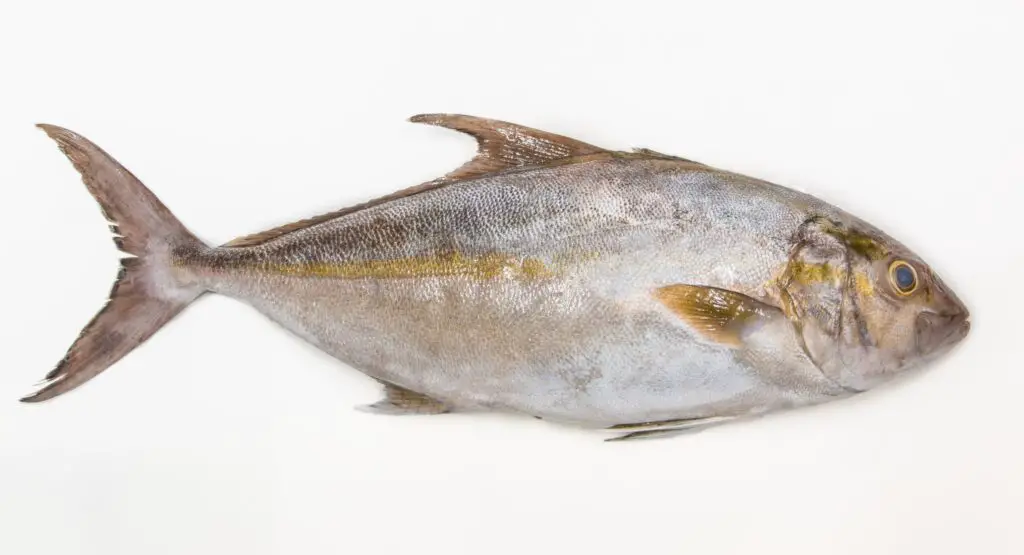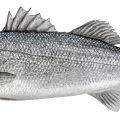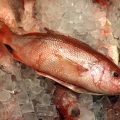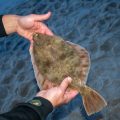Amberjack is from the Carangidae (Jack)family. The Carangidae family includes ray-finned fish like jacks, pompanos, and scads. They are commonly found in the Atlantic and Pacific Oceans. They like to live in the warmer parts of the sea. Small amberjack can be found on the upper surface of the sea near buoys or floating trash lines. The small amberjack is called the pilotfish. The larger ones live in the deep water like groupers. Amberjack and grouper are usually caught by bottom fishing in the deep sea, because they are bottom feeders.
Amberjacks have dark amber stripes from their nose to their dorsal fin. Their strips become darker and shine when they become excited. There are almost five types of amberjacks. They are greater amberjack, lesser amberjack, almaco jack, yellowtail, and banded rubber fish. The yellowtail amberjack is also called the Japanese amberjack. They are game fish or sports fish. This means they can be eaten after catching them, or people can release them because they are caught for entertainment purposes.
The grouper is from the Serranidae family. Serranidae is a large family. In this family, there are 400 different types of groupers. The basic characteristics of all groupers are the same, but the outlook is different from one kind to another. There are different types of groupers, like dusky groupers, Nassau groupers, etc.
Groupers are protogynous hermaphrodites. It means they can change their sex when they become mature. When they mature, they become female if they were male in their early stages, but amberjack gets mature at the age of three or four. The female one releases from 15 to 60 million eggs. They spawn primarily from March to June. They lay their eggs close to the reef or shipwrecks.

The Eating Habits of Grouper and Amberjack
Groupers eat reef fish, shrimp, squid, and crabs like amberjacks, but large groupers can also eat small sharks, octopuses, crustaceans, and turtles. The young grouper and amberjack eat tiny creatures and plankton. They like to ambush their prey by resting or hide in caves. When getting their desired prey, they just jump in front of them from a hidden place and suck them. They have teeth, but they do not bite. They open their mouths and create negative pressure in their mouths, sucking their food. Amberjacks hunt their prey normally like other predatory fish. Amberjack is excessively greedy. They finish their food very fast.
Amberjack is a fast-moving fish. They can swim at 50 km per hour. It is very difficult to catch them. On the other hand, groupers are slow-moving fish. They are visible from the top of the sea and down deep and easier to catch.
The largest amberjack can be 6 feet long, but the lesser amberjack is very small, not more than a foot. The larger one’s weight can be 60 to 80 lbs. On the other hand, the largest grouper is called goliath grouper and they could be 8 feet long and 300-600 lbs.
Amberjack is not harmful to humans, but groupers are known to attack humans in some circumstances. They are known to be a calm fish, but sometimes they become aggressive, especially the goliath grouper. They can hurt humans if they feel in danger. Amberjack could have a tapeworm or trypanorhynch plerocerci in their body. They will not be harmful if you cook them on high heat. On the other hand, groupers have high mercury levels in their bodies, and they should be avoided by pregnant and breastfeeding women.
How do Grouper and Amberjack live?
Amberjack likes to live in groups at an early age, but when they grow up, they start to live alone. Groupers live in small groups, and the groups are called harems. They like to travel to the coast or along the shelf edge. They are territorial and shy in nature. They need rest or a hiding place. They like to stay in their permanent house, which is behind a pile of rocks. Amberjacks are not good for aquariums. People do not keep them in their homes, but in commercial aquariums, you can find them. Tiny groupers can be kept in an aquarium, but they can’t live with other fish because they like to eat other fish, and they need hiding places in the aquarium.
What do Grouper and Amberjack taste like?
Amberjack is fairly like tuna and is pinkish in color, but they are not tuna. It has a rich buttery flavor. Their flavor is a mixture of tuna and mahi mahi. Its meat texture is like steaks, very close to swordfish. They do not have any special flavor, so the flavor depends on the seasoning. Smoking, pan frying, grilling, baking, anything is good for it. It is good in both ways, like raw and cooked. It is not very common, and if you want to cook amberfish, remove the tail, because it contains worms.
Amberjack is very popular in Japan, especially the yellowtail. This fish can be used raw in sushi, but not only in Japan. I love yellowtail personally. I enjoy it in a nice roll with avocado for a simply delicious roll. In restaurants, its demand is very high and to fulfill the demand in Japan, they farm this fish in Japan and Korea.
Amberjack and grouper can substitute for each other, but amberjack is tougher than grouper. They can also be substituted with mahi mahi and shark.
Grouper is mildly sweet and flaky, like lobster, but lobster has a unique flavor. Grouper is not as flavorful. The taste of grouper depends on the spice that you are mixing it with. Its subtle flavor can easily absorb the marinated spices, then they represent their ingredient flavor. It is a popular fish which is not very expensive, but due to its popularity, it has become expensive nowadays. The federal government also restricts the overfishing of grouper in many regions. Grouper is rich in vitamins, especially vitamin B6. They are a very good source of potassium. It is a very rich protein source but lower in cholesterol.











